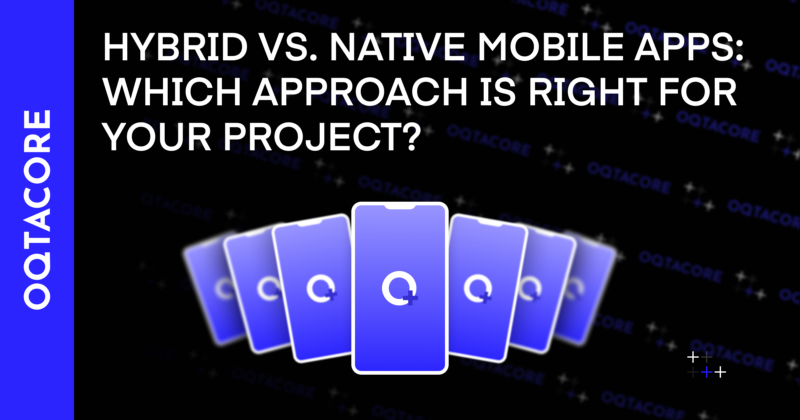
Which Approach is Right for Your Project?
When building a mobile app, one of the key decisions you’ll face is whether to develop it as a native app or use a hybrid (cross-platform) approach. Both methods have their strengths, and choosing the right one depends on your goals, timeline, and budget. In this article, we’ll break down the differences between native and hybrid apps, explore the pros and cons of each, and help you decide which approach is best for your mobile app development project.
What Are Native Mobile Apps?
A native app is built specifically for one platform, such as Android or iOS, using the platform’s own programming language and development environment.
Key Technologies Used in Native App Development
- Android: Kotlin is the primary language used for Android native app development.
- iOS: Swift is the preferred language for iOS apps.
Native apps are tightly integrated with the operating system’s features, providing a smooth, seamless user experience. However, they require separate development for each platform, meaning that two teams (one for Android, one for iOS) are typically needed.
Advantages of Native Apps
- Performance: Native apps are optimized for the specific platform, ensuring the best performance possible.
- Access to Device Features: Native apps have full access to hardware features, such as 3D cameras, laser measurements, and advanced sensors.
- More Predictable Results: Native apps are optimized for specific devices and screen sizes, ensuring better compatibility, especially with Android devices, which come in a wide variety of models.
Disadvantages of Native Apps
- Higher Cost: Developing separate apps for Android and iOS requires more resources, including two separate codebases and independent teams.
- Slower Development Time: Since native apps are built for each platform, the development process is twice as long as a hybrid approach.
- Limited Talent Pool: There are fewer developers skilled in Kotlin and Swift than in more common programming languages like JavaScript, making it harder to find talent.
In essence, while native apps offer superior performance and device integration, they come with a higher price tag and longer development time.
What Are Hybrid (Cross-Platform) Apps?
Hybrid apps, also known as cross-platform apps, are designed to work on multiple platforms with a single codebase. Using frameworks like React Native or Flutter, hybrid apps combine elements of native apps and web apps. These frameworks allow developers to write one set of code that can be compiled for both Android and iOS.
Popular Hybrid App Frameworks
- React Native: Built on JavaScript, React Native is widely used for hybrid mobile apps, including WhatsApp and Facebook.
- Flutter: A newer framework that uses Dart language to compile native code for Android and iOS, known for providing better performance and stability than React Native.
How Do Hybrid Apps Work?
Hybrid apps are essentially web apps that run inside a WebView, a browser-like widget without visible controls. While the app’s core is essentially a web page, it runs natively within the app, so the user won’t notice any difference.
- WebView: This is a browser window embedded within a native app that can run the web-based part of the application and handle business logic.
- React Native & Flutter: These frameworks compile the web app into platform-specific code, optimizing it for each platform while maintaining a shared codebase.
Advantages of Hybrid Apps
- Faster Development: With hybrid apps, you only need to write the app’s core logic once, reducing development time and costs.
- Cross-Platform Compatibility: A single codebase works for both Android and iOS, making it easier to maintain and update the app.
- Cost-Effective: Since you’re working with one codebase, development and maintenance costs are lower compared to native apps.
Disadvantages of Hybrid Apps
- Hardware Integration Limitations: Hybrid apps still require platform-specific code for accessing hardware features like gyroscope, Bluetooth, or GPS. However, basic features like camera access are usually available across both platforms.
- Performance Issues: Hybrid apps may suffer from slower performance and less responsiveness compared to native apps due to the extra layer of code and WebView.
- Quality Inconsistencies: There can be bugs and quality issues, particularly on less popular phone models or in cases where hybrid frameworks don’t support certain native features fully.
React Native vs. Flutter: Which One Should You Choose?
When considering hybrid development, two of the most popular frameworks are React Native and Flutter. Both have their pros and cons, so it’s important to understand the differences.
React Native
- Uses JavaScript: React Native is based on JavaScript, a widely-known language that many developers are already familiar with.
- More Developers: React Native benefits from a larger community of developers, making it easier to find support and resources.
- Performance: While React Native is generally faster than fully hybrid apps, it may still suffer from performance issues in some complex apps.
Flutter
- Uses Dart: Flutter uses its own programming language, Dart, which is not as widely known. However, Flutter apps tend to have better performance and more predictable results than React Native apps.
- Faster: Flutter apps are generally faster and more stable than React Native apps due to their more direct compilation into native code.
- Higher Cost: Flutter is typically 1.2x the cost of React Native, largely due to the fact that Dart is less commonly used and fewer developers are proficient in it.
When to Use React Native:
- You’re already using JavaScript in your organization.
- You need to get to market quickly with a lower budget.
When to Use Flutter:
- You want faster performance and better stability.
- You are willing to invest in a framework that offers higher quality over time.
When to Choose Native vs. Hybrid?
When to Choose Native Development
- Your app requires full access to native device features (e.g., 3D cameras, laser measurement).
- You need optimal performance and have the resources to invest in separate codebases for iOS and Android.
- You want to create a highly complex app, such as a 3D game or AR application.
When to Choose Hybrid Development
- You want to develop an app for both Android and iOS with a single codebase to save time and money.
- Your app doesn’t require intense hardware integration or cutting-edge performance.
- You’re working with a tight budget and need a faster time-to-market.
Conclusion: Making the Right Choice for Your Mobile App
Choosing between native and hybrid app development depends on the specific needs of your project. If you require high performance, access to native device features, and a tailored experience, native development is the way to go. However, if you’re looking for cost efficiency and faster development without sacrificing too much functionality, hybrid apps built with React Native or Flutter may be the right fit for your business.
Understanding the strengths and weaknesses of both approaches will ensure you make the best decision based on your budget, timeline, and app requirements.
Explore More About Mobile App Development:
- Web3 Products: Non-Custodial Wallets, Crypto Exchanges, and Tech Stack Considerations
- Understanding Programming Paradigms and Best Practices in Software Development
- Understanding Tech Stacks in Web3 Development
